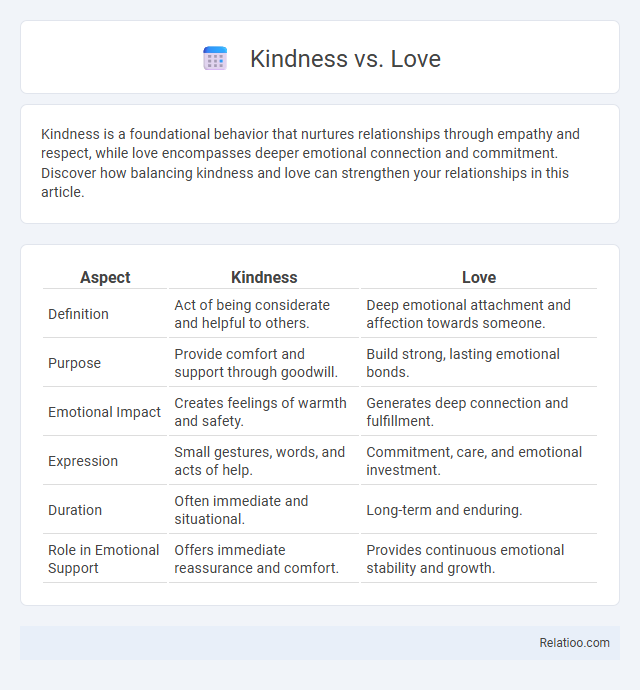Kindness is a foundational behavior that nurtures relationships through empathy and respect, while love encompasses deeper emotional connection and commitment. Discover how balancing kindness and love can strengthen your relationships in this article.
Table of Comparison
| Aspect | Kindness | Love |
|---|---|---|
| Definition | Act of being considerate and helpful to others. | Deep emotional attachment and affection towards someone. |
| Purpose | Provide comfort and support through goodwill. | Build strong, lasting emotional bonds. |
| Emotional Impact | Creates feelings of warmth and safety. | Generates deep connection and fulfillment. |
| Expression | Small gestures, words, and acts of help. | Commitment, care, and emotional investment. |
| Duration | Often immediate and situational. | Long-term and enduring. |
| Role in Emotional Support | Offers immediate reassurance and comfort. | Provides continuous emotional stability and growth. |
Defining Kindness: More Than Simple Acts
Kindness transcends simple acts of generosity, embodying a consistent attitude of compassion, empathy, and understanding toward others. Unlike love, which often implies deep emotional attachment and personal connection, kindness can be extended universally, regardless of relationship or circumstance. Defining kindness involves recognizing its power to foster positive social interactions, promote emotional well-being, and create a foundation for lasting trust and respect.
Understanding Love: The Deeper Connection
Understanding love reveals a deeper emotional connection that transcends kindness and sympathy, emphasizing empathy, trust, and commitment in relationships. While kindness involves actions that benefit others and sympathy reflects shared feelings, love integrates these qualities into a bond that nurtures your emotional well-being and fosters profound intimacy. Developing this insight enhances your ability to build meaningful and lasting connections with others.
Core Differences Between Kindness and Love
Kindness involves actions driven by empathy and consideration, often expressed through helpful or generous behavior without expecting anything in return. Love encompasses deeper emotional connections, attachment, and commitment, including both affection and care that influence long-term relationships. You can practice kindness as a conscious choice, while love integrates feelings that shape your personal bonds and sense of belonging.
The Role of Intent in Kindness and Love
Intent plays a crucial role in distinguishing kindness and love, with kindness often expressed through intentional acts of generosity and compassion directed towards others without expecting anything in return. Love encompasses a deeper, more complex intent that involves emotional bonding, care, and commitment, which drives actions beyond mere kindness to nurture and sustain relationships. Understanding the intent behind kindness clarifies whether it stems from genuine concern or social obligation, while love inherently carries intentionality aimed at long-term wellbeing and emotional connection.
How Kindness Impacts Relationships
Kindness fosters trust and emotional safety in relationships by promoting empathy and understanding between individuals. Acts of kindness enhance communication and reduce conflicts, creating a supportive environment where love can flourish. Consistent kindness strengthens bonds and deepens emotional connections, making relationships more resilient and fulfilling.
The Power of Love in Human Connections
The power of love in human connections transcends simple acts of kindness by fostering deep emotional bonds that nurture trust, empathy, and long-lasting relationships. While kindness involves compassionate gestures and love encompasses emotional commitment, love intensifies human connections by creating profound mutual understanding and support. Embracing this power strengthens your relationships, cultivating a sense of belonging and emotional security.
Can Kindness Exist Without Love?
Kindness can exist independently as an intentional act of goodwill or compassion toward others, often motivated by empathy or social norms rather than deep emotional attachment. Love, characterized by profound emotional connection and affection, enhances the authenticity and depth of kindness, making it more personal and enduring. While kindness without love may be genuine, it often lacks the intensity and commitment found when both coexist.
Expressions of Love Through Kindness
Expressions of love through kindness manifest in thoughtful actions, gentle words, and consistent support, demonstrating empathy and genuine care. Your ability to show kindness reflects a deep emotional connection, translating affection into meaningful gestures that strengthen relationships. Acts such as listening attentively, offering help without expectation, and appreciating others embody the powerful link between love and kindness.
Cultural Perspectives on Kindness vs Love
Cultural perspectives on kindness and love vary significantly, with kindness often viewed as a universal social virtue promoting harmony, while love is interpreted through diverse emotional, spiritual, and relational lenses across cultures. In collectivist societies, kindness emphasizes group welfare and social obligations, contrasting with individualistic cultures where love is deeply tied to personal fulfillment and romantic expression. Understanding these distinctions enhances cross-cultural communication and fosters empathy by recognizing how kindness and love manifest uniquely around the world.
Choosing Kindness or Love: Which Matters Most?
Choosing kindness or love depends on your personal values, but kindness often serves as the foundation for love by fostering empathy and compassion in relationships. Love encompasses deeper emotional connections and commitment, while kindness promotes everyday acts that improve social harmony and individual well-being. Prioritizing kindness can enhance your relationships by creating trust and positive interactions, ultimately supporting the growth of genuine love.

Infographic: Kindness vs Love
 relatioo.com
relatioo.com